Corporate Strategy in a Digital Age
Is the Internet really revolutionizing the business world? The answer is yes, in at least seven ways.
(originally published by Booz & Company)The Internet phenomenon has generated more press over the past 18 months than any other business topic. Has all the hype been justified? Is the Internet really revolutionizing the business world? Or is it - like so many other so-called technology revolutions of the past 20 years - merely the latest in a string of incremental technology improvements, one whose time might be over in a few short years?
Recently, Booz-Allen & Hamilton and the Economist Intelligence Unit (E.I.U.) undertook a joint project to understand what senior executives around the world are thinking - and doing - about the Internet. More than 525 executives from a wide range of industries completed a written or online survey (which was prepared in six languages); more than 100 others participated in two Thought Leadership Panels in New York and London or were interviewed individually.
The results of the research - which have been published by the E.I.U. under the title "Competing in the Digital Age: How the Internet is Transforming Corporate Strategy" - lead to an irrefutable conclusion: Quite simply, the Internet is reshaping the global marketplace and it will continue to do so for some time to come.
As the chairman and chief executive officer of the Bank of Montreal, Matthew Barrett, says, "We are only standing at the threshold of a New World. It is as if we had just invented printing or the steam engine." Mr. Barrett is not alone in his assessment. More than 90 percent of our survey respondents believe that the Internet will transform or have a major impact on their corporate strategy within the next two to three years. Moreover, more than 60 percent believe that the Internet will help their companies achieve their strategic goals within the next year or two. That is quite an achievement for a technology that no one except technophiles had even heard of four or five years ago.
The Internet is changing the way customers, suppliers and companies interact, creating huge opportunities as well as unforeseen competitive threats. In much the same way as it is redefining external relationships with suppliers, customers and alliance partners, the Internet is also changing the way companies work internally, collapsing boundaries and redefining relationships among different functions, departments and divisions. In just a few years, the Internet has profoundly affected the basis of competition in many industries. Instead of the traditional focus on product features and costs, the Internet is shifting the basis of competition to a more strategic level - changing the business models that companies use to organize themselves, engage in relationships and conduct their most basic transactions with customers and suppliers.
SURVEY FINDS MEGATRENDS
Our survey findings identify seven megatrends, all due - at least in part - to the rise of the Internet.
(See Exhibit I.)
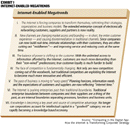
Exhibit I
In a nutshell, these portend the next major business transformation. Obviously, senior executives must understand these trends and their implications, especially because so many of them have already become potent forces for business change. Many executives have begun to realize competitive advantage from rethinking how the Internet will affect their companies, customers, suppliers and partners. They are restructuring their businesses accordingly to exploit one or more of these megatrends.
NEW BUSINESS MODELS
As senior executives realize what these Internet-enabled megatrends can mean for their companies, most see that they must develop congruent Internet strategies that may call for some dramatic changes in the way they do business. Most tellingly, old ways of thinking about one's place in the value chain are blurring past recognition. (See Exhibit II.)
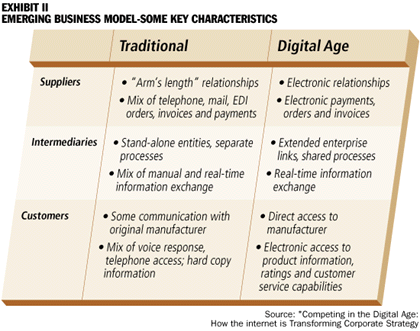
What is different about suppliers and customers today? When does it make sense to go to market through intermediaries? What kinds of relationships should a company build with its suppliers, its customers, its alliance partners?
Senior executives' responses confirm that the Digital Age has changed age-old definitions of what various groups are and do:
Intermediaries: Once a necessity for reaching customers in many industries, many intermediaries are at serious risk because producers can reach out directly to their end- customers via the Internet. To continue to be viable, these intermediaries will need to reassess what they bring to the table, most likely repositioning themselves in the process.
Suppliers: They face a host of similar challenges. How can they harness the Internet to get closer to their customers, retooling traditional processes to enhance customer service and deliver e-commerce solutions?
Customers: No more caveat emptor; with a wealth of product information from thousands of companies only a mouse click away, customers are in the driver's seat now.
ONE SIZE WILL NOT FIT ALL
Our survey participants caution their counterparts everywhere not to fall into the trap of thinking the Internet only provides new sales and marketing channels; rather, it impacts all the strategic weapons chief executive officers can use to build competitive advantage. An all-too-common mistake is to view the Internet simply as a new communication channel, failing to make it an integral part of the whole business. More than 90 percent of Fortune 500 companies have an Internet presence today, yet only 5 percent actually are generating online profits from e-commerce. Those companies that have successful, profitable online operations, including The Dell Computer Corporation, Cisco Systems, the Charles Schwab Corporation and the Microsoft Corporation, have all integrated their e-commerce objectives into their overall corporate strategies.
Other companies can learn from these masters. "There's almost nothing you're doing that you can't figure out some way to do better, faster and cheaper using the Internet," says Jim Harkness, vice president of TIAA-CREF, which provides retirement and insurance products for the education and research communities. "If you can't figure out a way to make the Internet help your business, that's not what's wrong with the Internet, that's what's wrong with you. ...There's almost nothing, there's almost no industry that I can think of today that can't enhance its bottom line in some way using the Internet."
Not surprisingly, the number of companies investing in all kinds of Web sites (i.e., public vs. "private" intranets and extranets) is growing. (See Exhibit III.)
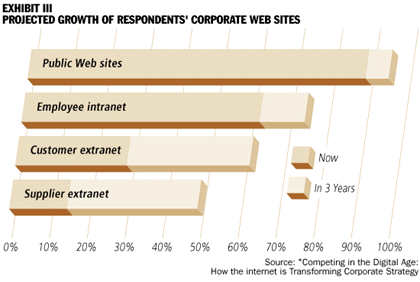
Interestingly, our survey respondents are forecasting that extranets (i.e., private sites accessed by people outside the corporation) will experience the most rapid and significant growth over the next three years. That is where senior executives see the biggest opportunities to develop new sources of competitive advantage with customers and suppliers. In fact, over the next three years, survey respondents believe that extranet deployment will more than double - from 32 percent of respondents' companies having them today to 65 percent having them within three years. They believe that building extranets will allow them to bring customers closer to their companies through the delivery of specialized services and also to reduce costs and improve efficiencies when such extranets are used with suppliers. Now that most large companies have already built the simpler Internet applications - public Web sites and intranets - and achieved some success with them, they're ready to capture the additional value that extranets can deliver.
IF YOU BUILD IT, THEY WILL COME
Clearly, senior executives are convinced that the Internet and related technology will revolutionize their businesses. While not everyone calculates their return on investment from Internet investments, senior executives know they must keep up with the Internet leaders in their industries or fall behind forever. As the chairman of the Intel Corporation, Andy Grove, recently exclaimed when someone asked him to quantify his company's payoff from Internet e-commerce, "What's my ROI on e-commerce? Are you crazy? This is Columbus in the New World. What was his ROI?"
Admittedly, to date few companies have seen measurable returns, but almost all are looking far past the short term: 90 percent of survey respondents are convinced that their companies will see a payoff from their Internet investments within three years. They are in wholly new territory, "betting on the come," but they believe this is a necessity. If they do not make substantial investments now, they risk being left in the dust a few years hence.
At BP Amoco P.L.C. and many other companies, Internet investments are seen as enablers. "You create an infrastructure capability. No one sits down and says, 'What has this done for me, what has this saved me?' It has become part of the way business is done," explains Jim Hood, information technology leader for BP Amoco's Global Business Center. Consequently, total investment for Internet products and services is expected to top $92 billion by the year 2000, according to the International Data Corporation. This represents an almost 50 percent compound annual growth rate for the computers, networking equipment, software and services necessary for building Internet infrastructure. This covers both the spending on creating e-commerce Web sites and the myriad of internal uses to which the technology is being applied.
Since Internet investments focus on building infrastructure, keeping pace with the market and building new capabilities, senior executives expect payoffs to come in many forms. (See Exhibit IV.)
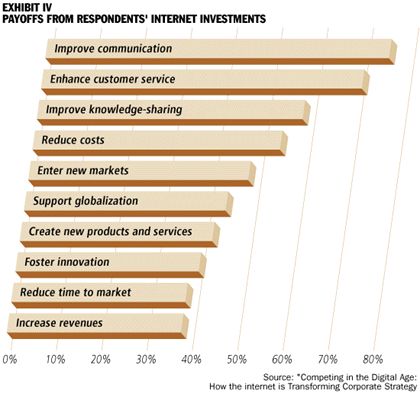
Not surprisingly, survey respondents attribute the greatest Internet value to those payoffs that touch the customer, such as "improving communication" and "enhancing customer service." These encompass benefits of customer loyalty, better targeting of customers, and more rapid response to customer and market demands. Survey respondents also point to a wide variety of channel-oriented payoffs, including new market entry, new product creation and globalization.
From an internal perspective, "improving knowledge-sharing" is judged to be the most valuable payoff, as companies reap savings when their employees waste less time searching for information contained within the organization. More importantly, knowledge-sharing has a multiplier effect on good ideas generated within a company. As more people have access to these ideas, they can be enhanced and executed more broadly.
Unfortunately, most of these Internet benefits are not easily quantified. To a great extent, this accounts for the surprisingly low number of respondents who believe their companies have already seen a payoff from their Internet investments. The monetary impact of "improved communications" or "improved knowledge- sharing" is difficult to assess. Yet senior executives assuredly see value in these "soft" benefits. They believe that they are positioning their companies for longer-term gains, and not relying strictly on orthodox metrics when evaluating their companies' Internet investments.
"WIRED" - NOT "TIRED"
Our survey underscores that the Internet is far more than just a new channel for selling products and services - it represents a seismic shift in how companies structure their operations, share knowledge, empower employees and get things done. Mr. Harkness of TIAA-CREF explains, "We are not going around looking for things that we can do on the Internet. We are looking at the work that is integral to our business and seeing how can we do that better on the Web." To compete effectively in the Digital Age, companies will need to evolve their business models from the tired, command-and-control hierarchies that developed with the Industrial Age to the wired organizations common among companies that have sprung up with the Internet.
William Thiele, vice president of the General Reinsurance Corporation, sums up the challenges and the opportunities of life with the Internet: "Internally the benefits are clear: It has speeded our business up tremendously; we're now effectively open 24 hours a day. People work from multiple locations in a collaborative environment... . Externally, this is both a challenge and an opportunity. We've been in the business a long time; we have a substantial investment in bricks and mortar. Our business model has emphasized face-to-face contact, personal relationships, direct marketing. We can easily envision someone setting up shop in Dublin or Honolulu or wherever they want to and accessing all of our customers without going through the trouble that we have. And if anyone else can do thay...we have to do it faster and better."
To paraphrase Mr. Thiele, the Internet will require - and truly enable - companies to become round-the-clock operations that can act more quickly and with more flexibility. It will restructure roles within the value chain by blurring boundaries between companies and their customers, suppliers, partners and even competitors. It will force chief executive officers to create new business cultures where innovation, change management and leadership through shared mission are paramount.
Senior executives who are positioning their companies to make the most of the Internet-enabled world understand that the Internet is truly revolutionizing all facets of business life. Although no one has figured out all the ramifications yet, most senior executives are certain that they must invest in the Internet and related technology - and, in some cases, invest heavily - or lose market share. By placing their bets on this new way of doing business, by ceasing to rely on old tools and traditional business rules, companies are preparing to emerge from the coming transformation on top.
For more information or to obtain the full findings of "Competing in the Digital Age: How the Internet is Transforming Corporate Strategy," please visit www.bah.com or www.eiu.com. ![]()
Reprint No. 99202
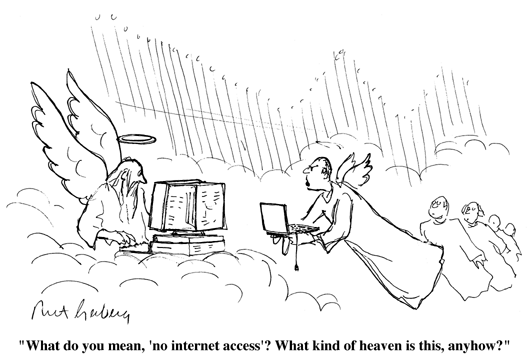
| Authors
Charles V. Callahan, Charles V. Callahan, a vice president of Booz-Allen & Hamilton, has worked for the past 12 years with clients in the communications, media, technology and consumer-products industries to improve their return on investments in information technology and to develop new business capabilities with Internet technologies. He holds a B.S. in management science from Pennsylvania State University. Bruce A. Pasternack, pasternack_bruce@bah.com Bruce A. Pasternack is a senior vice president with Booz Allen Hamilton in San Francisco. He is the coauthor, with Albert J. Viscio, of The Centerless Corporation: A New Model for Transforming Your Organization for Growth and Profit (Simon & Shuster, 1998). |



